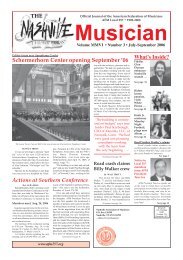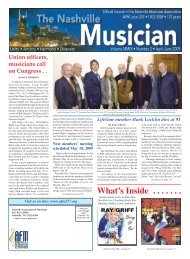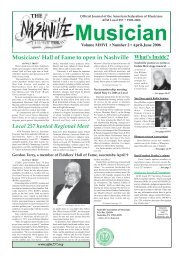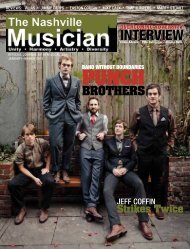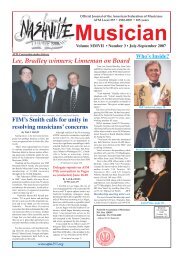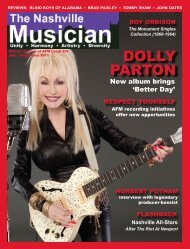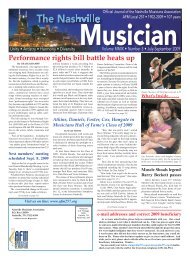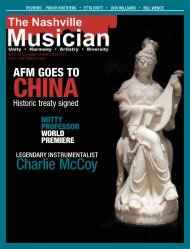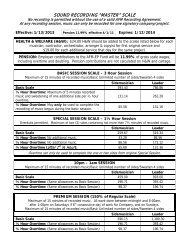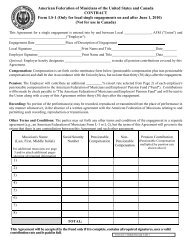Musicians Jan - 01 - Nashville Musicians Association
Musicians Jan - 01 - Nashville Musicians Association
Musicians Jan - 01 - Nashville Musicians Association
You also want an ePaper? Increase the reach of your titles
YUMPU automatically turns print PDFs into web optimized ePapers that Google loves.
<strong>Jan</strong>uary-March 2009 The <strong>Nashville</strong> Musician 29<br />
on it. MTV played them; Elvis cartoon characters<br />
playing around the pool. It did pretty good<br />
(when released in 1982).”<br />
Another challenge for Briggs was producing<br />
The Monkees’ Michael Nesmith: “I met The<br />
Monkees by playing on their things and Michael<br />
and I became friends. He asked me to produce<br />
one of his first solo albums.That was when he<br />
did the first part of ‘Elephant Parts,’ which was<br />
the first video we done. I was going through<br />
some strange stuff at the time, part of it being<br />
Elvis and Linda Thompson, which I don’t mind<br />
mentioning now, but back then I wouldn’t say<br />
anything about it.”<br />
Linda Thompson, of course, is the former<br />
Miss Tennessee who was Presley’s girlfriend<br />
for nearly five years, appeared on the syndicated<br />
TV series Hee Haw, co-wrote with Briggs,<br />
and was also wed to Olympic swimmer Bruce<br />
Jenner and later composer David Foster.<br />
“Michael was going through the same thing<br />
with his wife and best friend, a very similar situation,”<br />
continues Briggs. “So my head wasn’t<br />
even into his album, but I stayed with him and<br />
did all the tracks, until it was finished. I told<br />
him I wanted to quit the job, and didn’t really<br />
want anything to do with it. He didn’t understand<br />
that, but I told him my head wasn’t into<br />
it, and didn’t feel like I did a good job. So I<br />
didn’t get credit, but Michael gave me a little<br />
pay-off later after it sold a few records. It was<br />
an emotionally-strange sort of thing. I’ve still<br />
got pictures of he and I.”<br />
Despite his busy studio schedule, Briggs<br />
found time to perform in a band of session players<br />
called Area Code 615, its name derived from<br />
<strong>Nashville</strong>’s telephone code. The players recorded<br />
back-to-back albums “Area Code 615”<br />
and “A Trip In the Country” in 1969 and 1970,<br />
respectively.<br />
The band of all-stars included Briggs on piano;<br />
Norbert on bass; Weldon Myrick on steel;<br />
Kenny Buttrey, drums; Mac Gayden; Pete<br />
Wade, dobro; Charlie McCoy, harmonica; and<br />
Wayne Moss, lead guitar.<br />
“Elliot Mazer produced this at Cinderella<br />
Studios for Polydor Records (with an assist<br />
from Buttrey). It’s developed a cult following.”<br />
Mazer worked in the studio with such VIPs<br />
as Santana, Sinatra, Switchfoot and The Who.<br />
Area Code 615’s smooth blending of blues, rock<br />
and country were expemplified by their singles<br />
“Southern Comfort” and “Why Ask Why.”<br />
“You know, before going into the studio we<br />
played baseball out in the yard, just prior to<br />
cutting stuff,” grins Briggs. “Who pulled that<br />
sound together? Well, the other guys will be mad<br />
if I say in an interview that Mike Nesmith’s the<br />
one that put those sounds together or that<br />
Charlie McCoy made it work. Charlie was the<br />
most serious musician, and still is.”<br />
With Jerry Kennedy, Briggs cut the successful<br />
Top 40 1987 instrumental “Hymne”<br />
for Mercury, but credited it to Joe Kenyon, the<br />
name being an inside joke: “The reason being<br />
that if it succeeded we didn’t want to go on the<br />
road to plug it. Well, we did do a few station<br />
promotions, and made the cover of R&R (trade<br />
weekly). But they got calls from like The Tonight<br />
Show inviting us on. We were busy with<br />
studio work.”<br />
David explained that their nom de plume<br />
came from Jerry’s attorney, inspired by<br />
Kennedy’s initials J.K., resulting in Joe Kenyon.<br />
For the most part, did producing give him a<br />
greater sense of satisfaction?<br />
“I never did want to be a producer. But the<br />
thing that I’ve done that paid me more than the<br />
Elvis stuff was Willie Nelson’s ‘Shotgun Willie’<br />
album (1973). I was producer on that, coming<br />
in behind Jerry Wexler (Atlantic’s executive<br />
producer) and Arif Mardin, the great producer<br />
who just died a few years back.”<br />
Briggs worked on the set in both <strong>Nashville</strong><br />
and Memphis. He smiled recalling the time he<br />
and Willie were being interviewed on TV regarding<br />
their project: “The guy asked him which<br />
is the most important, the music or the lyrics?<br />
Willie said, ‘Let me think on that while you talk<br />
to David.’ So I said, ‘Well, you can’t hum a<br />
lyric.’ Willie laughed, he liked that.”<br />
In 1988, he began production on a (Virgin<br />
Records) project that warmed his heart, working<br />
with Roy Orbison: “I started some good stuff<br />
with Roy, but unfortunately you’ll never hear<br />
it. Don Was was president . . . I was the leader<br />
on it and Don just loved it, but it was completely<br />
redone after Roy’s untimely death (Dec. 6,<br />
1988).<br />
“Then Barbara, Roy’s widow, wanted me to<br />
redo the songs with different musicians. She<br />
wanted me to take Reggie Young off the track<br />
and add Eric Clapton. I said, ‘I’m not going to<br />
do it.’ Roy loved Reggie and once even said,<br />
‘Man, that’s my favorite guitar player.’ So a lot<br />
of those songs, she and the guy from England<br />
did with name musicians. She wanted as many<br />
name players as she could get.<br />
“I produced the vocals that were on that album<br />
(‘King of Hearts,’ released in 1992), and I<br />
did get credit on one track ‘Wild Hearts Run<br />
Out of Time,’ a theme for a movie considered<br />
about Marilyn Monroe and Albert Einstein. One<br />
of my writers wrote it. We produced the<br />
soundtrack on Roy and got credit for that.”<br />
It was probably in 1990, says Briggs, when<br />
Owen Bradley approached him about re-doing<br />
some of the Patsy Cline product. “He said,<br />
‘We’re going to do all the Patsy Cline stuff over.<br />
I’ve managed to isolate her voice . . .’ and had<br />
those Korean three-tracks, I think they were,<br />
and her voice was totally isolated, singing all<br />
those haunting classics. Owen said, ‘What I<br />
want you to do is totally change it, hire a rhythm<br />
section, strings, the whole bit and write the arrangements<br />
. . .’<br />
“I said, ‘Oh my God, I’m gonna get crucified<br />
and all these critics will say, ‘You’re messing<br />
with the classics.’ Owen said, ‘They already<br />
have that other stuff! I did that 30 years ago,<br />
whatever. I want to do another to show these<br />
songs could’ve been done another way, like we<br />
do today.’ So I hired Reggie (Young) and all<br />
the more modern guys and we produced a totally<br />
different album. Owen loved it. But a lot<br />
of people hated it. Well, they forgot to put my<br />
name on it and Owen apologized.<br />
“When they put out a single - it may have<br />
been a version of ‘Faded Love’ - it says ‘Arranged<br />
by David Briggs’ . . . When he was still<br />
mixing, they sent me a tape and Owen wrote<br />
on there, ‘It’s not quite there, but it’s almost<br />
there.’ I still have that.”<br />
With good buddy Norbert Putnam, he<br />
opened the <strong>Nashville</strong>-based Quadrafonic Studios:<br />
“We had Quad together, starting out in ’69<br />
on thru ’79. We could trust each other. Norbert<br />
had the savvy and daring, with adventure in his<br />
heart. Ours was the first studio with three-channel<br />
headphones, a choice of stereo - all the singers<br />
wanted themselves louder than anything -<br />
That studio was the first to offer anything more<br />
than monaural in this town. And we had Quad-<br />
8 - we thought the four-channel sound was going<br />
to be the big thing, but as it turned out, it<br />
wasn’t, because the consumer couldn’t afford<br />
to buy the hardware.<br />
“When we sold it, I had to sign a three-year<br />
non-compete clause. So officially, House of<br />
David started in 1982, though I already had the<br />
studio, but before that just for me. I couldn’t<br />
open it to the public; actually I built that studio<br />
with Elvis in mind, but he died before we got it<br />
finished. I had already quit the road with him,<br />
though we were going to do some of his stuff<br />
in there.”<br />
Who was the first to record in Briggs’ latest<br />
studio?<br />
“Joe Cocker was the soulful antithesis of like<br />
nothing I was doing. He was the first guy to<br />
use my House of David, so I started off with a<br />
big one . . . Neil Young cut ‘House of Gold’ in<br />
the studio.”<br />
For some 20 years, David and co-director<br />
D. Bergen White were music directors for the<br />
Country Music <strong>Association</strong>’s awards shows.<br />
Briggs also did This Country’s Rockin’, a 10hour<br />
HBO Special; and a 2-1/2 hour TV Special<br />
in tribute to Grand Ole Opry comic grand<br />
dame Minnie Pearl.<br />
Briggs’ playing’s heard on the recordings of<br />
such artists as Barbara Mandrell, Kenny Rogers,<br />
Loretta Lynn, Mark Chesnutt, Reba McEntire<br />
and Tom Jones.<br />
Smiling, Briggs points out, “I played on two<br />
or three of his albums, but I never met Tom<br />
Jones. Back in the early 1980s I could’ve met<br />
him one time in Los Angeles, as he wanted me<br />
to come out and do the strings. But I would have<br />
missed like 20 sessions. You used to not cancel<br />
sessions. That was the kiss of death.”<br />
Who’s his favorite producer to work with?<br />
Unhesitantly he replies Owen Bradley:<br />
“When I was playing piano for Owen, he could<br />
put the fear of God in you, because he expected<br />
that you were able to do it. You never got to<br />
play piano until it’s time to cut. He played the<br />
piano and rehearsed with the strings, the whole<br />
group and the arrangements. You’re just standing<br />
there. Everybody’s used to what he’s played,<br />
and he was playing some incredible stuff, then<br />
he’d say, ‘OK, let’s roll it!’ You’ve got to sit in<br />
and he’s recording it and you haven’t even run<br />
through it. All of a sudden, Owen might say,<br />
‘Bring it up a half-step,’ which may have taken<br />
it from B-flat to B-natural, which changed all<br />
the music and you’re transposing . . . I did that<br />
because I was scared to death, and you know<br />
what, I’m glad I did.<br />
“After working for him, playing for all those<br />
David Briggs recently at the Union.<br />
Following session, Tommy Roe (guitar) with Muscle Shoals associates (from left) Rick Hall,<br />
Jerry Carrigan, Felton Jarvis, Ray Stevens, David Briggs and Norbert Putnam.<br />
Roy Orbison, Jeff Carlton and David Briggs take a break from recording.<br />
- Kathy Shepard photo<br />
other producers was a joke. Owen actually knew<br />
what he was doing. Most of the others didn’t<br />
know anything; they’d just set the clock and sit<br />
in there and drink. But listen to his records, how<br />
great they still are.”<br />
It was in 2000 that David stepped back after<br />
45 years working steady: “I quit and<br />
wouldn’t even go downtown for a year. I was<br />
just burned out.”



